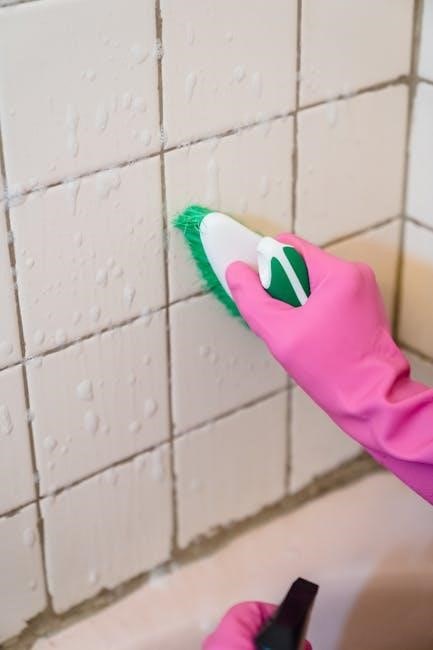wilbarger brushing protocol instructions pdf

wilbarger brushing protocol instructions pdf
The Wilbarger Brushing Protocol, developed by Patricia Wilbarger, is a sensory integration technique using a soft-bristled brush to reduce sensory defensiveness and improve nervous system organization.
1.1 Overview of the Wilbarger Brushing Protocol
The Wilbarger Brushing Protocol, also known as the Deep Pressure and Proprioceptive Technique (DPPT), combines brushing with joint compressions to address sensory processing challenges. It involves using a soft-bristled surgical brush to apply firm, long strokes on specific body areas, followed by gentle joint compressions to enhance sensory modulation and nervous system organization. This technique is typically administered by trained occupational therapists to ensure safe and effective implementation.
1.2 History and Development of the Protocol
The Wilbarger Brushing Protocol was developed by Patricia Wilbarger, an occupational therapist, to address sensory defensiveness. Initially known as the Wilbarger Brushing Protocol, it later evolved into the Deep Pressure and Proprioceptive Technique (DPPT). This approach combines brushing with joint compressions to provide deep pressure input, aiming to improve sensory modulation and nervous system organization. It has become a widely recognized tool in sensory integration therapy.
1.3 Importance of the Protocol in Sensory Integration Therapy
The Wilbarger Brushing Protocol is a cornerstone in sensory integration therapy, offering a structured approach to reduce sensory defensiveness and enhance nervous system regulation. By providing deep pressure input, it helps individuals, especially children, manage sensory overload and improve their ability to focus and engage in daily activities. Its effectiveness has made it a widely adopted technique in occupational therapy practice;

Benefits of the Wilbarger Brushing Protocol
The Wilbarger Brushing Protocol offers numerous benefits, including reduced sensory defensiveness, improved focus, and enhanced body awareness. It aids in nervous system organization and sensory modulation.
2.1 Reduction of Sensory Defensiveness
The Wilbarger Brushing Protocol effectively reduces sensory defensiveness by applying deep pressure through controlled brushing. This technique stimulates nerve endings, helping the nervous system process sensory input more efficiently. Regular use can lead to improved tolerance of sensory stimuli, fostering a calmer and more regulated response to environmental factors, particularly benefiting children with tactile defensiveness or sensory processing challenges.
2.2 Improvement in Focus and Attention
By enhancing sensory modulation, the Wilbarger Brushing Protocol improves focus and attention in individuals, especially children. The deep pressure applied during brushing helps organize the nervous system, reducing sensory overload and distractions. This allows individuals to concentrate better on tasks, leading to improved academic and functional performance, particularly in environments requiring sustained attention and engagement.
2.3 Enhanced Body Awareness and Nervous System Organization
The Wilbarger Brushing Protocol enhances body awareness by providing deep pressure, which stimulates nerve endings, improving sensory processing and nervous system organization. This leads to better motor planning and coordination, helping individuals understand their body’s position and movement more effectively, which is especially beneficial for those with sensory processing challenges.

Materials and Equipment Required
The Wilbarger Brushing Protocol requires a soft-bristled surgical scrub brush stored in a sealed container to maintain hygiene and prevent drying.
3.1 Surgical Scrub Brush Specifications
The Wilbarger Brushing Protocol requires a soft-bristled, non-scratch surgical scrub brush. The brush must be gentle on the skin, avoiding any discomfort or irritation. It should be made of durable, high-quality materials to ensure consistent pressure application. Proper storage in a sealed container is essential to maintain hygiene and prevent bristle drying, ensuring optimal performance during therapy sessions.
3.2 Proper Storage and Maintenance of the Brush
The surgical scrub brush should be stored in a sealed plastic bag or container to prevent drying and contamination. Regularly clean the brush with mild soap and rinse thoroughly. Allow it to air dry completely before storage. Proper maintenance ensures the brush remains effective and hygienic for repeated use in therapy sessions, maintaining its gentle texture and performance.
Step-by-Step Instructions for the Brushing Technique
Hold the brush horizontally, applying firm, even pressure. Use quick, long strokes to brush arms, legs, back, palms, soles, and buttocks, covering each area thoroughly;
4.1 Preparing for the Brushing Session
Gather the soft-bristled surgical brush and ensure the environment is calm. Hold the brush horizontally and apply firm, even pressure. Brushing is most effective on bare skin, but can be done over clothing if necessary. Maintain continuous contact with the skin to avoid startling the child. Ensure the child is comfortable and ready to begin the session.
4.2 Brushing Pattern and Sequence (Arms, Legs, Back, Palms, Soles)
Begin with long, steady strokes on the arms, starting at the shoulders and moving downward. Repeat on legs, back, palms, and soles. Brush each area 10 times with firm pressure, ensuring full coverage. Avoid repetitive strokes on the same spot. The sequence promotes even sensory input and organization, following the natural direction of nerve pathways for optimal effectiveness.
4.3 Applying the Correct Pressure and Stroke Direction
Use firm, steady pressure with the brush, ensuring bristles bend slightly. Hold the brush horizontally and move in long, consistent strokes. Direction matters—stroke upward on arms and legs, and outward on the back. Maintain continuous contact to avoid startling the nervous system. Avoid light or irregular pressures, as this can be counterproductive to the sensory integration goals.

Joint Compressions Following Brushing
Joint compressions are applied after brushing to provide deep pressure, aiding sensory integration and nervous system regulation, enhancing the protocol’s effectiveness and therapeutic benefits.
5.1 Purpose of Joint Compressions
Joint compressions are applied to provide deep pressure input, enhancing sensory integration and calming the nervous system. They target major joints like shoulders, elbows, hips, knees, and ankles, promoting organization of sensory input and reducing sensory defensiveness. This step follows brushing to maximize therapeutic benefits and support overall nervous system regulation, aiding in emotional and physical stability.
5.2 Technique for Administering Joint Compressions
Joint compressions involve applying gentle, firm pressure to major joints using a specific grip. Compressions are administered to elbows, knees, shoulders, hips, and ankles, 3-5 times each. The technique requires slow, steady pressure held for 3-5 seconds. This step should only be performed by a trained occupational therapist to ensure safety and effectiveness, following the brushing sequence for optimal sensory integration benefits.

Frequency and Duration of the Protocol
The Wilbarger Brushing Protocol should be administered every 2 hours, with each session lasting 2-3 minutes. Occupational therapists guide the frequency and duration adjustments based on individual needs.
6.1 Recommended Schedule for Brushing Sessions
The Wilbarger Brushing Protocol is typically recommended to be performed every 2 hours, with each session lasting 2-3 minutes. Consistency is key to achieving optimal results. The schedule may vary based on individual needs, particularly for children with sensory processing difficulties. Always follow the guidance of a trained occupational therapist to ensure the protocol is administered correctly and safely.
6.2 Duration of Each Session
Each brushing session typically lasts 2-3 minutes, ensuring the protocol is brief yet effective. The process includes brushing and joint compressions, designed to be completed quickly to maintain the child’s focus and cooperation. Consistency in session duration helps achieve the desired sensory modulation benefits while fitting into daily routines seamlessly.
Safety Precautions and Contraindications
The Wilbarger Brushing Protocol must be administered by a trained professional to avoid misuse. It should not be used on individuals with certain medical conditions or skin sensitivities. Proper technique is essential to prevent irritation or discomfort. Contraindications include open wounds, eczema, or fragile skin. Always follow guidelines to ensure safe and effective application.
7.1 Contraindications for the Protocol
The Wilbarger Brushing Protocol is contraindicated for individuals with open wounds, eczema, or fragile skin. It should not be used on areas with active rashes or irritation. Additionally, those with severe sensory sensitivities or medical conditions that could be exacerbated by deep pressure should avoid this technique. Proper professional guidance is essential to ensure safe application.
7.2 Safety Guidelines for Administering the Technique
The Wilbarger Brushing Protocol should only be administered by a trained occupational therapist. Ensure the brush is used on bare skin, held horizontally, and applied with firm, even pressure. Avoid using the brush on broken or sensitive skin. The technique should not be performed without proper professional guidance, and it is essential to follow the recommended schedule provided by the therapist.

Training and Certification Requirements
Proper training and certification are essential to administer the Wilbarger Brushing Protocol effectively. Only licensed occupational therapists should perform the technique after receiving specialized instruction and guidance.
8.1 Role of Occupational Therapists in Administering the Protocol
Occupational therapists play a crucial role in administering the Wilbarger Brushing Protocol. They ensure the technique is performed correctly, adhering to specific guidelines and safety precautions. Therapists assess the individual’s needs, provide personalized instructions, and monitor progress to maximize the protocol’s effectiveness while minimizing potential risks. Their expertise is vital for achieving the desired sensory integration benefits.
8.2 Importance of Professional Guidance
Professional guidance is essential for safely and effectively administering the Wilbarger Brushing Protocol. Trained occupational therapists ensure proper technique, address individual needs, and prevent potential risks. Incorrect application can lead to discomfort or ineffective results, emphasizing the need for expert supervision. Professional oversight guarantees the protocol is adapted to the individual, maximizing benefits while maintaining safety and therapeutic integrity.

Common Questions and Misconceptions
Common questions include whether the protocol can be self-administered or requires professional guidance. Misconceptions often involve its complexity or effectiveness without proper training or technique.
9.1 Addressing Myths About the Wilbarger Brushing Protocol
One common myth is that the protocol is merely a simple brushing technique, when in fact it involves precise methods and joint compressions requiring professional training. Another misconception is that it is only for children, though it can benefit adults too. Proper execution is essential for effectiveness, and it should not be attempted without guidance from a trained occupational therapist.
9.2 Frequently Asked Questions
Common questions include whether the protocol is suitable for all ages and if joint compressions are always necessary. Many inquire about the required pressure and stroke direction. Others ask if the brush can be used over clothing or if it’s only for sensory defensiveness. Professional guidance is often sought to ensure proper technique and safety, especially for children and adults with specific needs.
The Wilbarger Brushing Protocol is a valuable tool for reducing sensory defensiveness and improving focus. It remains a widely recognized technique in sensory integration therapy, offering effective results when properly administered by trained professionals.
10.1 Summary of Key Points
The Wilbarger Brushing Protocol, developed by Patricia Wilbarger, is a sensory integration technique using a surgical scrub brush to reduce sensory defensiveness and improve focus. It involves specific brushing patterns followed by joint compressions, typically administered by trained professionals. The protocol is highly effective for individuals with sensory processing difficulties, offering benefits like enhanced body awareness and nervous system organization when implemented correctly.
10.2 Final Thoughts on the Effectiveness of the Protocol
The Wilbarger Brushing Protocol has proven to be a highly effective tool in sensory integration therapy, offering significant benefits for individuals with sensory processing challenges. By reducing sensory defensiveness and improving nervous system organization, it enhances daily functioning and quality of life. Proper administration by trained professionals ensures maximal benefits, making it a valuable intervention for those in need of sensory modulation support.